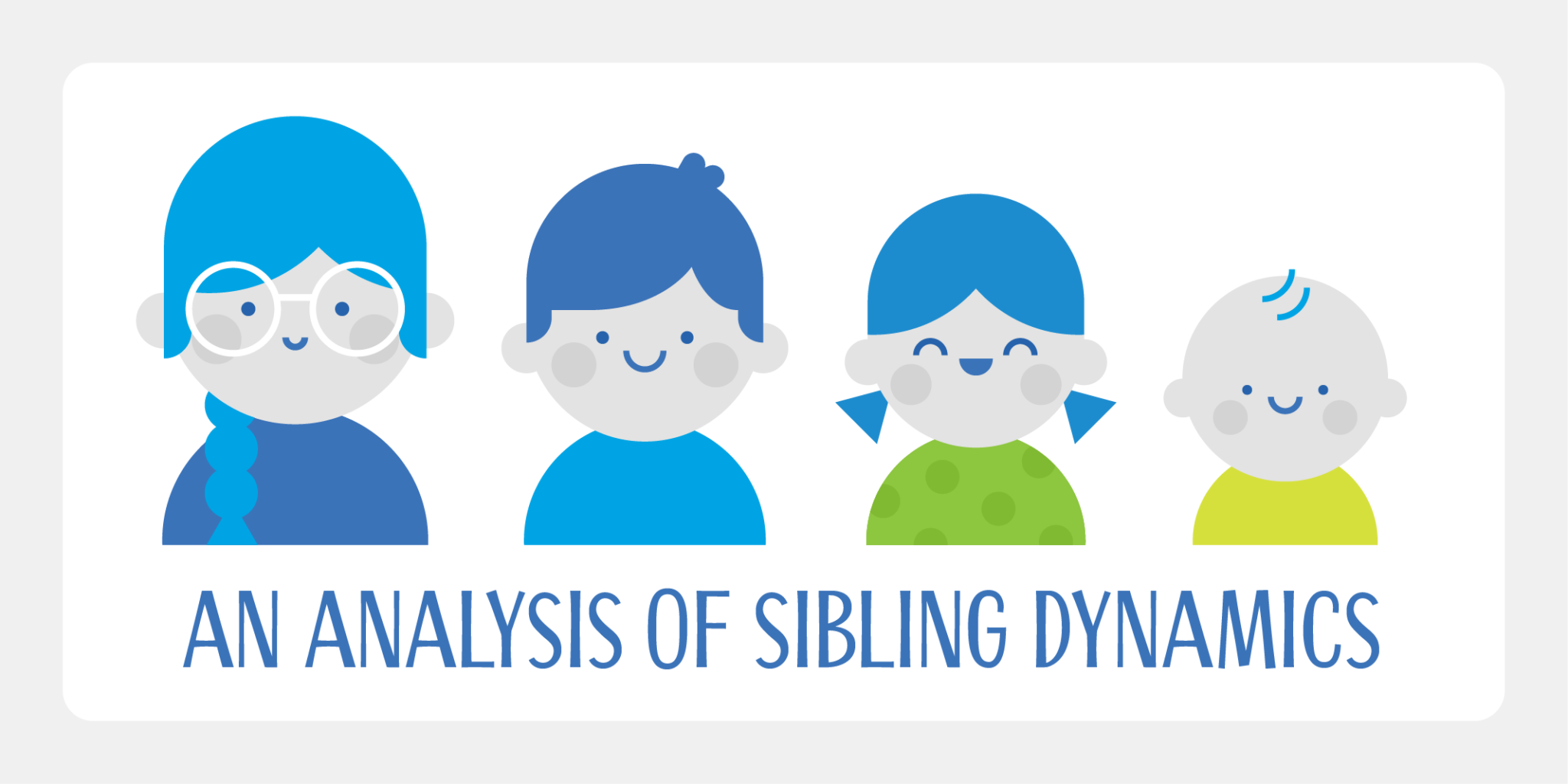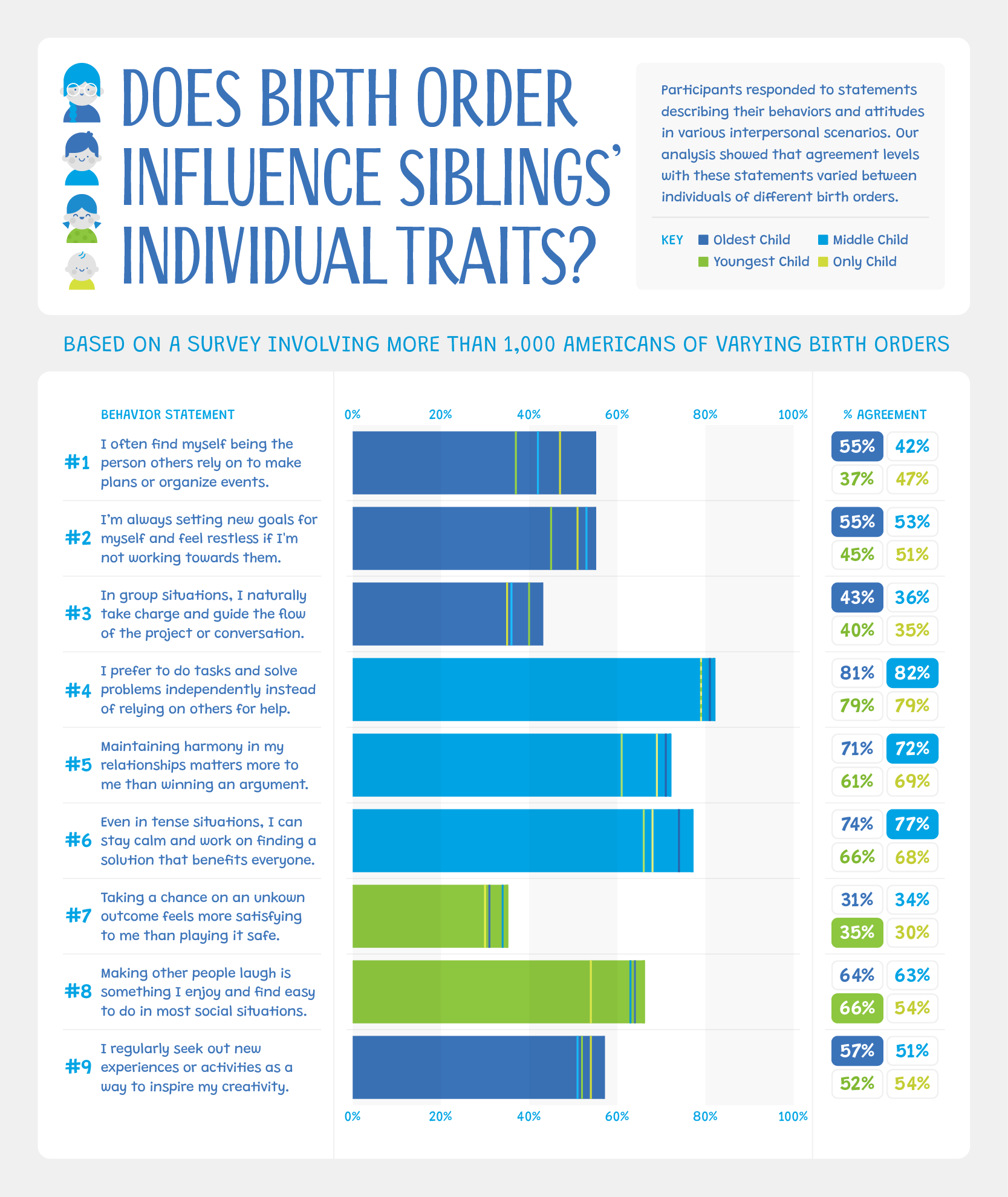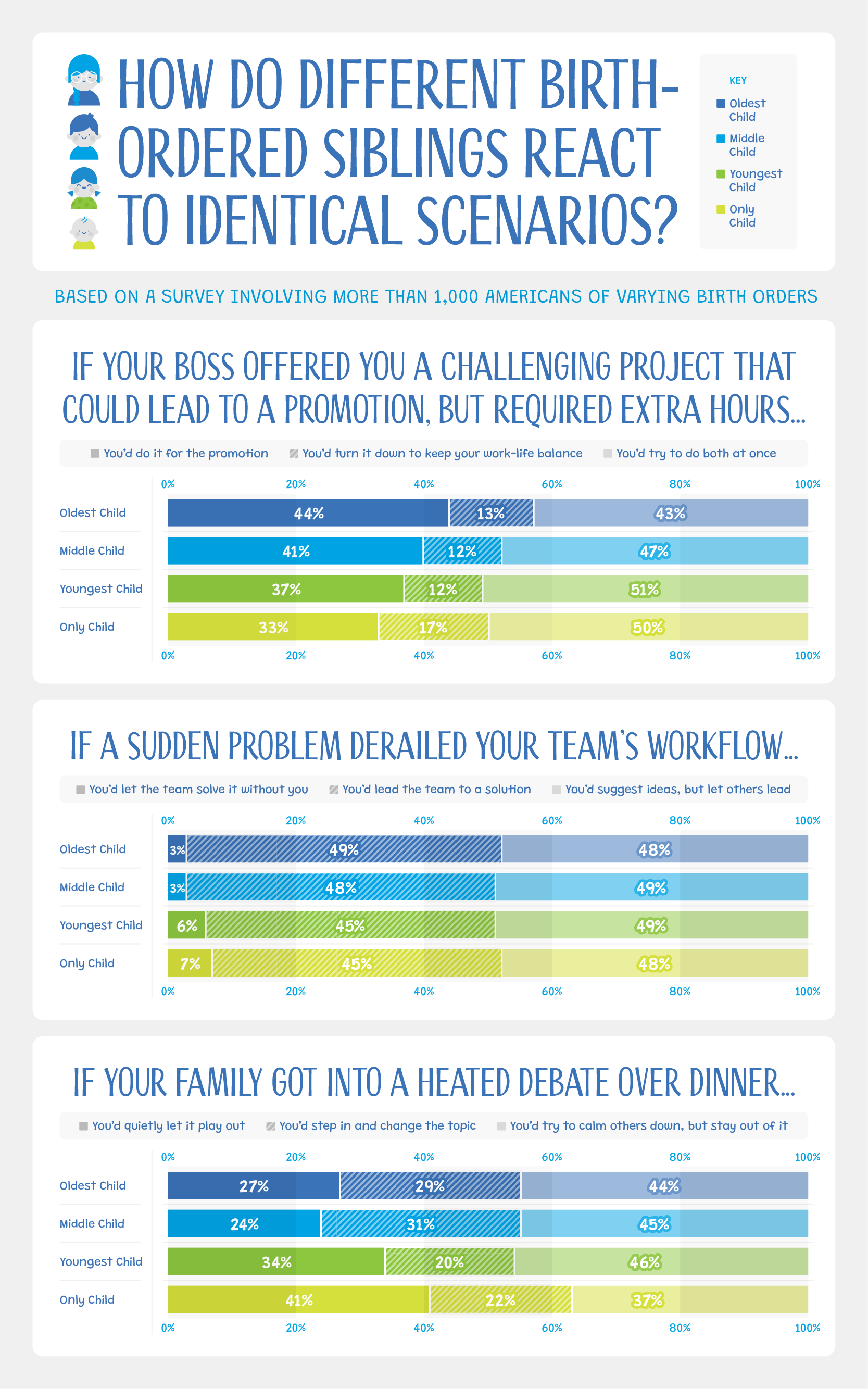
Have you ever wondered how much your place in the family hierarchy shapes who you are? Birth order theories suggest that whether you’re the oldest, middle, youngest, or only child, your place in the family hierarchy can significantly influence your personality and behavior.
At Coventry Direct, we embarked on a study to delve into these theories, surveying over 1,000 Americans to understand how different sibling positions might manifest distinct traits and responses to various scenarios.
From leadership and ambition to peacemaking and creativity, we explored some stereotypical traits associated with each sibling order to see if these labels hold true or if personality is more complex than our birth order might suggest. Join us as we aim to uncover the truth behind how our family roles could potentially shape our personal and professional lives.
Decoding Sibling Personalities: A Look into Birth Order and Behavioral Traits

In our exploration of whether birth order impacts personality traits, we surveyed over 1,000 Americans of different sibling positions. Each participant rated their agreement with behavior statements that reflect certain stereotypical traits associated with their birth order. The aim was to uncover whether individuals align with a few conventional traits that are sometimes ascribed to oldest, middle, and youngest children.
Insights on Oldest Child Stereotypes
The role of the oldest child is often seen through the lens of responsibility and leadership. Our survey findings provide interesting insights into this stereotype:
- Responsibility in Planning (#1): When asked if they find themselves organizing events or making plans, 55% of the oldest children agreed, indicating a significant inclination towards taking on responsible roles. This compares to 47% of only children, 42% of middle children, and 37% of youngest children who agreed with the same statement.
- Ambition and Goal-setting (#2): The drive to achieve significant goals is another trait typically associated with oldest children. About 55% of oldest children confirmed they are constantly setting new goals for themselves, a sentiment that is slightly less prevalent among other siblings—53% of middle children, 51% of only children, and 45% of youngest children also agreed.
- Leadership in Group Dynamics (#3): In group situations, 43% of the oldest children reported that they naturally take charge, which is higher than the responses from youngest children (40%), middle children (36%), and only children (35%).
These findings indicate that while the oldest children do show a higher tendency toward the stereotypical traits of responsibility, ambition, and leadership, these traits are not exclusive to them. Middle, youngest, and only children also exhibit these qualities, though the prevalence varies.
Insights on Middle Child Stereotypes
Middle children are often characterized as independent thinkers, adept negotiators, and natural peacemakers within their families. Our survey investigated these stereotypes by asking participants from various sibling orders to respond to behavior statements reflecting these traits. Here’s what we discovered:
- Independence in Problem-Solving (#4): A striking 82% of middle children agreed that they prefer to tackle tasks and solve problems independently. This was slightly higher than the oldest (81%), youngest (79%), and only children (79%), indicating a strong inclination towards independence across all sibling orders, with middle children leading marginally.
- Value of Harmony Over Winning (#5): Middle children are reputed to prioritize harmony over conflict, and our findings underscore this trait, with 72% agreeing that maintaining relationship harmony is more important than winning an argument. This is notably higher compared to 61% of the youngest children who agreed, suggesting that middle children may indeed be more oriented towards peacekeeping.
- Calmness and Compromise in Tense Situations (#6): Furthermore, 77% of middle children stated they remain calm and work towards compromise in tense situations, the highest among all groups. This compares with 74% of oldest children, 68% of only children, and 66% of youngest children.
These insights highlight not just the presence of expected traits in middle children but also illustrate that while certain characteristics may be slightly more pronounced in them, other sibling orders also share these traits to varying degrees.
Insights on Youngest Child Stereotypes
Youngest children often carry the reputation of being the free spirits of the family—more willing to take risks, naturally funny, and creatively inclined. Our survey probed these stereotypes by examining how different sibling orders relate to behavior statements associated with these characteristics. Here are the key findings:
- Willingness to Take Risks (#7): Regarding risk-taking, 35% of youngest children agreed that “playing it safe feels less satisfying than taking a chance,” which is slightly higher than the 34% of middle children, 31% of oldest children and 30% of only children who felt the same. This suggests a marginal tendency for youngest children to embrace risk, although the differences are not stark.
- Humor in Social Situations (#8): Youngest children are often seen as the entertainers within families, and our data supports this notion to some extent. 66% of youngest children agreed that making people laugh is something they enjoy and find easy, compared to 64% of oldest children and 63% of middle children. Interestingly, only children were less likely to identify with this trait, with 54% agreement.
- Seeking New Experiences for Creativity (#9): When it comes to seeking new experiences to fuel creativity, 52% of youngest children agreed with the statement, which is slightly less than the 57% of oldest children and 54% of only children who said the same. This suggests that while youngest children are indeed open to new experiences, they are not significantly more inclined towards creativity compared to other siblings.
These findings illustrate that while youngest children may slightly lean towards the stereotypical traits of being risk-takers, humorous, and creative, these characteristics are not exclusive to them. Siblings from different orders also exhibit similar tendencies, highlighting the complex interplay of factors that influence personality traits beyond simple birth order.
Does Birth Order Dictate How Siblings Handle Identical Situations?

In our continued effort to understand how sibling order influences personality traits, we presented survey participants with hypothetical scenarios designed to gauge their reactions in specific situations.
Scenario 1: A Challenging Project at Work
Participants were asked how they would respond if offered a challenging project at work that could lead to a promotion but would also require extra hours. Their responses shed light on their work-life balance preferences and career ambition:
- Dive in for the Promotion: Oldest children showed the highest propensity to fully commit to the project, with 44% choosing to dive in for the promotion. This aligns with the stereotypical view of oldest siblings as ambitious and leadership-driven. Middle children and youngest children were slightly more cautious, with 40% and 37%, respectively, indicating a slightly lower tendency to pursue aggressive career advancements. Only children were the most hesitant, with just 33% opting to dive in.
- Say No, Keep the Current Balance: A small percentage of respondents from each sibling order chose to completely decline the opportunity in order to maintain their current work-life balance. Only children showed a slightly higher preference for maintaining balance, with 17% opting out of the project, compared to 12% of youngest and middle children, and 13% of oldest children.
- Take It but Keep Balance: Interestingly, the majority of youngest children (51%) and only children (50%) preferred to take on the project while still trying to maintain balance. This response was also popular among middle children (47%) and oldest children (43%).
These insights suggest that while oldest siblings may be more inclined to fully commit to career advancement, younger and only siblings are more likely to seek a balance, integrating ambitious projects with efforts to maintain personal well-being.
Scenario 2: A Sudden Challenge in Team Projects
In the second scenario of our survey, we explored how individuals from different sibling orders react when their team encounters a sudden challenge that could potentially derail a project. This scenario tests their leadership skills, collaborative tendencies, and willingness to engage directly in problem-solving.
- Hope the Team Resolves It Without You: Very few participants across all sibling orders chose to step back and hope the team resolves the issue without their involvement. Only 3% of both oldest and middle children took this passive approach, slightly less than the 6% of youngest children and 7% of only children. This reflects a general tendency among all sibling orders to engage rather than withdraw from problem-solving in team settings.
- Lead the Team to Find a Solution: Demonstrating strong leadership qualities, 49% of oldest children chose to lead the team in finding a solution, closely followed by 48% of middle children. This high level of direct engagement is slightly less prevalent among the youngest and only children, both at 45%. These figures underscore a strong inclination towards leadership among the oldest and middle siblings, which aligns with traditional perceptions of these groups as natural leaders and responsible figures within their families.
- Suggest Ideas but Let Others Lead: A significant proportion of respondents from each sibling order preferred a collaborative approach, where they would suggest ideas but allow others to take the leadership role. This was the chosen response for 48% of oldest and only children, and a little higher for middle and youngest children, both at 49%.
These responses illustrate a generally proactive and involved attitude across sibling orders when faced with team challenges, with slight variations in the preference for leadership roles. Oldest and middle children are slightly more likely to assume a direct leadership role, while youngest and only children show a greater tendency towards collaboration and support
Scenario 3: Handling Heated Debates at Family Dinners
The third scenario in our survey examines how individuals of different sibling orders handle conflict during family gatherings, specifically when a heated debate erupts at a dinner. This scenario offers insights into their conflict resolution styles and their tendency to engage or withdraw in tense social situations.
- Stay Quiet, Let It Unfold: This option, which represents a more passive approach to conflict, saw the highest preference among only children, with 41% choosing to stay quiet and observe. Youngest children were also relatively more inclined to take this approach, with 34% opting to stay out of the fray. In contrast, only 27% of oldest children and 24% of middle children chose to remain silent, indicating their lesser tendency to disengage from family conflicts.
- Step In and Change the Topic: When it comes to actively diverting the conversation to avoid escalation, middle children showed the highest tendency to intervene, with 31% choosing to step in and change the topic. This is in line with their peacemaker stereotype. Oldest children were also somewhat inclined to this approach, with 28% trying to steer the conversation away from conflict. Youngest children (20%) and only children (22%), however, were less likely to take charge in redirecting the discussion.
- Try to Calm Things, But Stay Back: Demonstrating a balance between engagement and direct confrontation, a significant portion of each sibling order preferred to try to calm the situation without stepping fully into the spotlight. Youngest children led slightly in this regard with 46%, closely followed by middle children at 45%, and oldest children at 44%. Only children were less likely to engage in this manner, with 37% preferring to somewhat involve themselves in calming the situation.
These findings reveal that while no sibling order is completely averse to engaging in family conflicts, there are nuances in how they prefer to manage such situations. Middle and oldest children tend to engage more actively, either by changing the topic or attempting to calm things down, reflecting their roles as mediators and leaders within the family. Youngest children, while also inclined to help calm situations, show a greater likelihood to observe quietly. Only children show the highest tendency to remain passive, possibly due to their experiences in smaller family units where direct engagement may have been less necessary.
Closing Thoughts
Our comprehensive survey of over 1,000 Americans has revealed intriguing patterns about how sibling order might influence personality traits and behavioral responses.
Notably, oldest children are most likely to embrace leadership roles, with 44% willing to take charge in groups or projects, underscoring their ambition and reliability. Middle children, known for their negotiating skills and peacemaking, are least likely to shy away from conflicts, often stepping in to calm situations or change topics during heated debates. Youngest children, while slightly more inclined to observe conflicts passively, still show a significant propensity towards creativity and social engagement, with a notable 66% enjoying making others laugh.
These findings reveal that while sibling order may impact specific personality traits, the variations are subtle and frequently intersect across different birth orders. It’s important to acknowledge that our investigation focused on a limited set of traits and was designed to provide an initial, surface-level exploration. A more extensive and deeper analysis could yield more definitive insights. Our survey aimed to begin this exploration, setting the stage for further research into how our birth positions shape us.
At Coventry Direct, we recognize the uniqueness of each individual’s journey and needs. Just as personality traits vary among siblings, so do the financial and life circumstances that lead one to consider selling their life insurance policy.
Whether you’re the responsible eldest, the peace-making middle, the creative youngest, or an independent only child, Coventry Direct is here to help you understand your options, such as choosing a life settlement to realize more value from your life insurance than a surrender or lapse might offer. Explore your options today, and take a step towards securing your financial future.
Methodology
On March 14th, 2024, Coventry Direct conducted a comprehensive self-report survey involving 1,003 Americans of different birth orders. Participants evaluated themselves against a series of statements that reflect common traits that could be stereotypically attributed with different birth orders: oldest, middle, youngest children. We measured the degree of agreement with these traits across different sibling groups and analyzed the percentages of respondents who aligned with each characteristic. Additionally, we presented scenario-based questions to uncover any consistent patterns in how siblings of various orders react to identical situations. This approach helped us explore the potential correlations between birth order and specific personality traits, offering insights into whether certain sibling positions are more likely to exhibit distinct behavioral traits.

